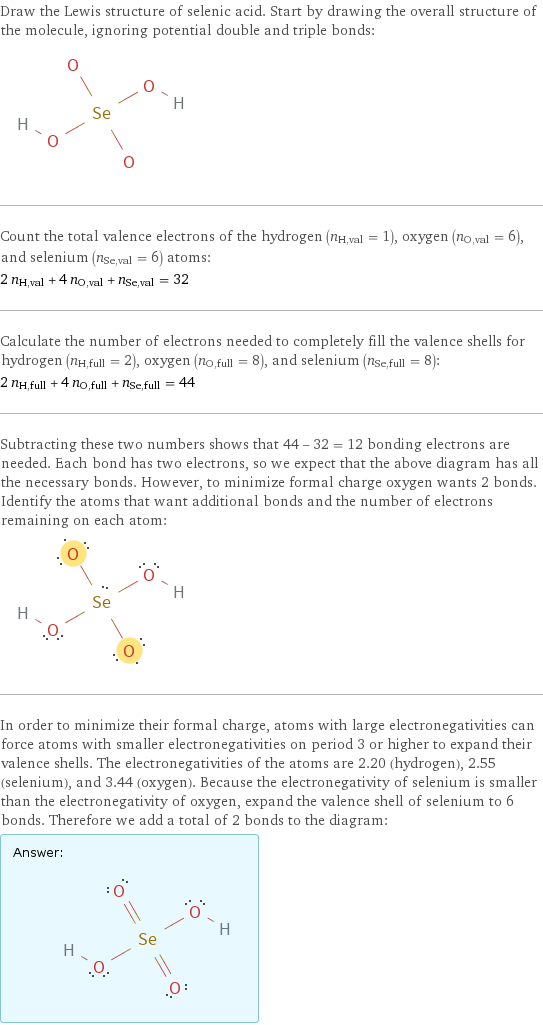Input interpretation

selenic acid
Chemical names and formulas

formula | H_2SeO_4 Hill formula | H_2O_4Se name | selenic acid mass fractions | H (hydrogen) 1.39% | O (oxygen) 44.1% | Se (selenium) 54.5%
Lewis structure

Draw the Lewis structure of selenic acid. Start by drawing the overall structure of the molecule, ignoring potential double and triple bonds: Count the total valence electrons of the hydrogen (n_H, val = 1), oxygen (n_O, val = 6), and selenium (n_Se, val = 6) atoms: 2 n_H, val + 4 n_O, val + n_Se, val = 32 Calculate the number of electrons needed to completely fill the valence shells for hydrogen (n_H, full = 2), oxygen (n_O, full = 8), and selenium (n_Se, full = 8): 2 n_H, full + 4 n_O, full + n_Se, full = 44 Subtracting these two numbers shows that 44 - 32 = 12 bonding electrons are needed. Each bond has two electrons, so we expect that the above diagram has all the necessary bonds. However, to minimize formal charge oxygen wants 2 bonds. Identify the atoms that want additional bonds and the number of electrons remaining on each atom: In order to minimize their formal charge, atoms with large electronegativities can force atoms with smaller electronegativities on period 3 or higher to expand their valence shells. The electronegativities of the atoms are 2.20 (hydrogen), 2.55 (selenium), and 3.44 (oxygen). Because the electronegativity of selenium is smaller than the electronegativity of oxygen, expand the valence shell of selenium to 6 bonds. Therefore we add a total of 2 bonds to the diagram: Answer: | |
Basic properties

molar mass | 144.98 g/mol density | 2.511 g/cm^3
Units

Thermodynamic properties

specific heat of formation Δ_fH° | solid | -3.656 kJ/g molar heat of formation Δ_fH° | solid | -530.1 kJ/mol molar heat of fusion | 14.4 kJ/mol | specific heat of fusion | 0.09932 kJ/g | (at STP)
Chemical identifiers
(=O)O InChI identifier | InChI=1/H2O4Se/c1-5(2, 3)4/h(H2, 1, 2, 3, 4)/f/h1-2H RTECS number | VS6575000 MDL number | MFCD00012191](../image_source/d0c54cdf1f354b9a388f524d70e52d2f.png)
CAS number | 7783-08-6 PubChem CID number | 1089 SMILES identifier | O[Se](=O)(=O)O InChI identifier | InChI=1/H2O4Se/c1-5(2, 3)4/h(H2, 1, 2, 3, 4)/f/h1-2H RTECS number | VS6575000 MDL number | MFCD00012191